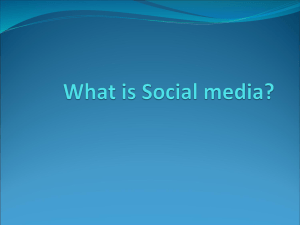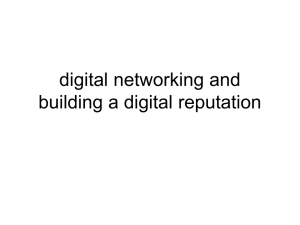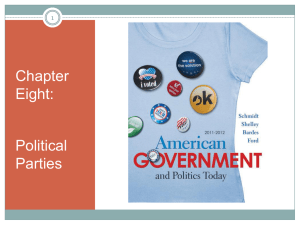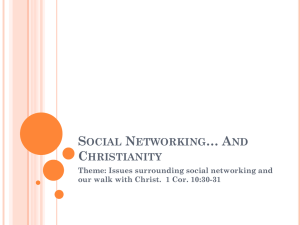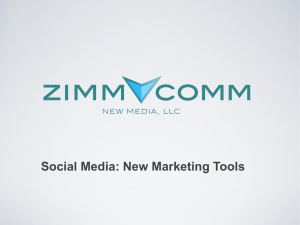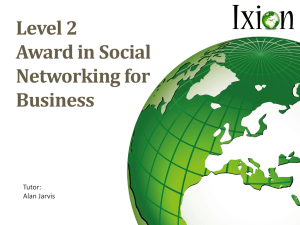Are Minority Parties more likely to Campaign Online
advertisement
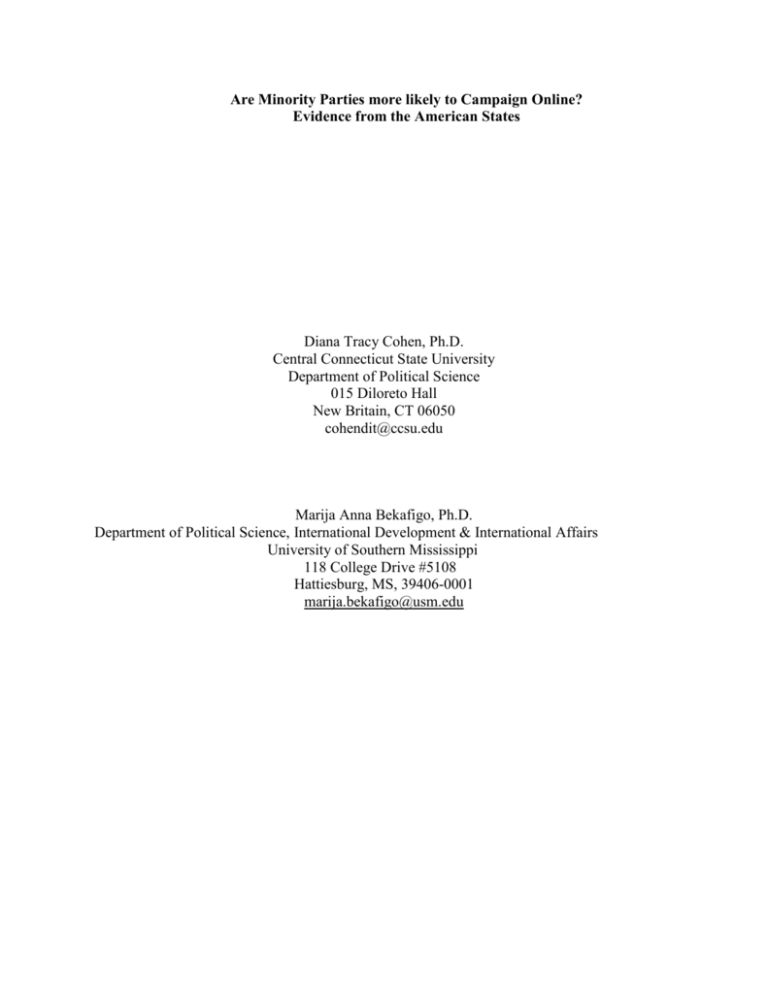
Are Minority Parties more likely to Campaign Online? Evidence from the American States Diana Tracy Cohen, Ph.D. Central Connecticut State University Department of Political Science 015 Diloreto Hall New Britain, CT 06050 cohendit@ccsu.edu Marija Anna Bekafigo, Ph.D. Department of Political Science, International Development & International Affairs University of Southern Mississippi 118 College Drive #5108 Hattiesburg, MS, 39406-0001 marija.bekafigo@usm.edu Like the political institutions that surround them, state parties are increasingly turning to the Internet for campaigning and networking purposes. From the creation of YouTube channels, to personalized log-in features, to interactive calendars, state parties have been testing the waters of new digital technology. This paper investigates the conditions under which a state party is most likely to embrace social networking technology. Applying the outparty thesis (Karpf, 2009; Key, 1949) to digital politics, this paper asks a key question: do minority parties in state legislatures try to connect with constituents and potential voters on their party’s website more often as compared to their majority party counterparts? Previous scholarship contends that the outparty, or minority party in the state legislature, must work harder to gain voters’ attention (Karpf, 2009; Key, 1949). We apply this question to an Internet politics context, seeking to understand if this fact manifests itself in outparties increasing their digital presence and sophistication as a means of getting back into power. Further, this paper offers the first analysis of partisan trends in social networking on the state level. Examining Facebook, YouTube, Twitter, Flickr, and Delicious, we offer a new way for measuring online presence which can be extended beyond analysis of state parties.1 This research is based on content analysis of the Democratic and Republican Party websites for all fifty states during the 2010 election cycle. We examine trends on the most popular social media websites and introduce an original and comprehensive measurement of online social networking presence. This measure is unique because it allows scholars to combine candidate and party use of multiple websites to reach voters into one determinant of online presence. This is an evolution from prior scholarship in that it moves away from examining each social networking site separately. By creating a collective measure of social networking presence we get a better sense of how technologies come together to shape party networking and outreach 2 efforts. In addition, the collective online presence measure is easily modified to account for changes in Internet politics over time. This study presents the most current and comprehensive analysis of Democratic and Republican state parties’ online behavior and deepens our understanding of how the Internet is used to further the reach of state parties. Examining variables such as the balance of power in the state legislature, we explore the conditions under which state parties are most likely to turn to the Internet for political campaigning purposes. We also expand the notion of online presence to include Flickr and Delicious, powerful social media sites that scholars have yet to explore. The data reveal that the majority party, not the outparty, has greater online presence. We also find that state party organizational strength and expenditures are significant predictors of higher online presence. Finally, contrary to literature examining national party trends, state Republican parties outpace their Democratic counterparts. These results suggest that the Internet is a permanent instrument in the campaigning and networking toolbox of state parties. We expect to see the most sophisticated party organizations and candidates use Web-based tools to their full potential in future studies. This paper proceeds as follows. First we review the literature on political parties’ campaigning function and situate the state parties in the context of current Internet research. Next, we explain why we use Facebook, YouTube, Twitter, Flickr and Delicious as determinants of online presence and how we conceptualize that idea. The third section reveals our independent variables and hypotheses which are positioned within the existing Internet politics and political parties’ literature. The fourth section presents the analysis and results. We conclude that state parties, entities that have oft been criticized for their lack of political engagement, are making strides in outreach efforts in the realm of online politics. 3 Parties, Campaigning, and the Internet Political parties are multi-faceted entities that perform a number of important political functions. To help us better understand what these functions are, V. O. Key (1958) suggested a tripartite model of party: party in the electorate, party in office, and party organization. Under the umbrella of party organization, numerous scholars argue that political parties primarily perform service functions (Aldrich, 1995; Bibby, 1998; Frantzich, 1989; Hernson, 1998; Kayden & Mahe, 1985). In furthering our understanding of this service function, scholars have examined the relationship between parties, candidates, and political action committees. A resounding conclusion in this literature is that one of the most important services that parties provide is to mobilize voters (Wielhouwer, 2000). With the integration of the Internet into American politics, voter mobilization has spread into the virtual world. State parties have followed their national party counterparts in gravitating to the Internet as a means of voter outreach. One question that looms is the degree to which integration and utilization of digital technology actually matters. To answer this, we can look at the impact of the Web in a broader political context. The Internet began to take its place in candidates’ repertoires during the 1996 election cycle (Casey, 1996; Rash, 1997). A presidential election year, Bill Clinton and Bob Dole both utilized the Web in creative new ways that set a standard for online politics (Margolis, Resnick, & Tu, 1997). Other down ballot races showed signs of Web-based campaigning, but this was far from commonplace. Campaign Web pages were typically very bare, offering no interactivity, limited information, and very few media images (Farmer & Fender, 2005; Stone, 1996). Often all one would find is a single photograph, contact and biographical information, and brief policy positions (Gibson & McAllister, 2005). Scholars argued campaigns were still stuck in the 4 broadcast media model, neglecting to consider the great potential benefits of the Internet as a new communications medium (Selnow, 1998). The coming of the 1998 election cycle saw more than two-thirds of open-seat House and Senate candidates using the Internet as a medium for campaign communication (Dulio, Goff, & Thurber, 1999). As opposed to 1996, where campaign Web pages provided little more than very basic information, great advancements in contribution solicitations, interactivity, and communication forums became a hallmark of online campaigning during the 1998 election. With the coming of the new century, Web pages became increasingly complex, using HTML language and multimedia flash to create impressive graphics and aid in the construction of interactive features. One of the biggest developments in the 2000 election cycle was Republican presidential candidate John McCain and his utilization of the Internet for fundraising purposes (Fritz, 2000). His online fundraising success was critical during the primary season, with estimates indicating he raised an unparalleled $500,000 after the New Hampshire primary. He also raised multiple millions of dollars from that point through the conclusion of the campaign (Birnbaum, 2000). In the 2008 election cycle, Barack Obama brought web-based voter outreach to unprecedented levels. Through the usage of online features such as MyBarack.com, a personalized log-in directly on the campaign homepage, Obama was able to connect with potential voters (Cohen, 2009). The success of Obama and others in the online world likely triggered state parties to place more emphasis on their online presence. Due to the lack of literature on state political parties, how much emphasis is a question left unanswered (Farmer & Fender, 2005).2 Measuring Online Presence 5 With rapid changes in the media landscape, measuring the concept of online presence, our dependent variable, is not an easy task. Simply “being online” is no longer a sufficient measurement. Democrats and Republicans in all 50 states have already adopted their own website. This does not mean, however, that all state parties embrace social media to the same extent. This fact challenges us to recognize that online presence is a “multifaceted concept” that is difficult to measure (Gainous & Wagner, 2011, 35). We present a new approach for measuring the online presence of state parties which introduces new social networking sites to previous models and combines the popularity of these sites into one dependent variable. Three social networking tools examined in this paper—Facebook, Twitter, and YouTube—have been the focus of several recent studies therefore, it seems obvious to include them in our examination of parties use of social networks (Gulati & Williams, 2010; Hanna, Sayre, Bode, Yang, & Shah, 2011; Rogers, 2003). But why examine Flickr and Delicious, too? We did not randomly choose these sites. Our analysis includes each of these five social networking sites—Facebook, Twitter, YouTube, Flickr, and Delicious—because they were the ones that the state parties included links or icons to on their website’s homepage. We infer the parties deemed these social networking sites important enough to subscribe to them and include a way for voters to connect with them through the homepage on their website. Parties linking to multiple social networking sites not only consider it an important way to keep in touch with voters, but they are trying to keep ahead of, or at least keep up with, changes on the web which may lead to votes and/or contributions. Although the Internet is no longer a new technology, the use of social media sites for keeping in touch with voters is still in its infancy. While most Internet users, including candidates and parties, are familiar with Facebook, Twitter and YouTube even if they are not subscribers, Flickr and Delicious are less familiar. 6 Flickr is best recognized as a photo sharing website, but it is quickly becoming a standard tool in campaigning because candidates and their campaigns can quickly upload pictures and video and share them on multiple websites at once, including Facebook, YouTube, Twitter and more. Delicious is the first and arguably the Web’s most popular Social Bookmarking service which allows users to save, share, and organize their bookmarks. Delicious also allows subscribers to see what is currently popular on the web including news or information about candidates and campaigns. More importantly for this study, these five social networking sites are recognized by the state parties as being a potentially useful tool because they have links to them on the homepage of their websites. Parties do not purport to know which sites are best at making a connection to voters or if that link can be made effectively by winning elections. Scholars have not even made that determination. Nobody can predict what future Websites will take off and gain popularity on the Web. One day MySpace was the most popular site because one could personalize their pages, but that quickly lost popularity and Facebook took its spot at the top (Anderson, 2011). Parties that try multiple sites, less popular sites, or new sites for reaching out will be the most successful. Moreover, Flickr and Delicious may not be the most popular social networking sites, but they may serve different purposes or reach different types of voters. After all, it does not cost parties much to set up these sites and our findings suggest that it may be a successful endeavor. The social media sites analyzed here are not created equal and some are invariably more popular with potential voters than others. We used content analysis to determine which networking sites were most popular. After accessing the official website of all 100 state parties, we tallied the number of times a link to any social networking site appeared. Facebook, Twitter, YouTube, Flickr, and Delicious were the only sites that the parties displayed links to during the 7 data collection period. Since each of these sites vary in overall popularity, we weighted each of those links using cues from Google PageRank to approximate online presence (Gainous & Wagner, 2011). PageRank assigns each webpage a ranking of its relative importance within the web community (wikipedia.org, “PageRank”). Based on these rankings, Facebook ranked the highest, followed by a tie between Twitter, Flickr and YouTube for second. Delicious received the lowest ranking according to PageRank. Therefore, we expect a party that is only linking to Facebook to be more successful in the online campaign than one only linking to Delicious. Likewise a party connecting to all five social networking sites should be the most successful. Since there are three different rankings for these social networking sites, we gave each party a weighted social networking score depending on whether their homepage displayed a link to each social networking site. Parties with a Facebook page received a 3. Parties with a Twitter, YouTube, or Flickr page received a 2 and parties with a link to Delicious received a 1. We combine the state parties weighted networking score into an indicator of online presence as our dependent variable. States with a weighted score of 0-5 were coded as having low online presence and parties with a score of 6-10 were coded as having high online presence. Therefore our dependent variable is coded 0 = low online presence, 1 = high online presence. There are some limitations to our measure of online presence. We do not claim to examine every possible way that a state party may attempt to connect themselves with potential voters on the web. Nor does our measure identify every possible social networking site that a party may be linked, with well over 100 of them in existence ("List of social networking websites," wikipedia.org). We only consider the social networking sites that the parties deem important enough to link voters to on their homepage. In addition, existing studies measure online presence by analyzing one website at a time, however we do not disregard these studies 8 altogether (Gulati & Williams, 2010; Hanna, et al., 2011). Our measure draws from previous studies that use social networking sites independently and allows scholars to examine the use of these sites under the roof of one predictive model. This allows us to test the overarching reach of parties’ online presence, not just whether they have an account on one or two sites where voters can be reached. Determining Online Presence: Testing the Outparty Thesis Testing the outparty thesis is primary goal of this paper, but we also examine other variables that consider power dynamics within a state and other key components of state politics research. This includes factors such as who holds the majority, as well as the strength of that majority, in the state legislature. Power dynamics in the state matters for the concept of outparty incentive. As V.O. Key illuminates, the battle of American political parties can be described as one pitting the “ins” versus the “outs” (1949, 302). The “outs” have an incentive to put greater efforts into campaigning. By contrast, the party “in” power spends more time legislating. Karpf (2009) applies this concept to the Internet in what he calls the “Outparty Innovation Incentives thesis.” Karpf notes that there are “a host of incentives that lead the opposition party to more actively embrace strategic and technological innovations of all sorts” (2009, 3). Technology is a cost-effective mechanism for outparties to connect with people. If the Outparty Innovation Incentives thesis holds true, minority parties that are out of power in both the state House and Senate should be the more likely to utilize technology. Additionally, we have good reason to believe that legislative professionalization (Squire, 2007) may be a factor in explaining web presence. States with greater legislative capabilities embraced e-government sooner than others and continued to make strides in providing and improving these innovative technologies to the state’s citizenry (Mossberger, Tolbert, & McNeal, 2008). 9 Beyond looking at state party dynamics, this study considers other possible determinants of online presence and are grounded by current Internet and politics literature. In an attempt to measure the likelihood that a national party or candidate will use social networking tools, scholars have gravitated towards examining two sets of variables. One set of typical predictors tests attributes of a candidate's constituency such as education, income, ethnicity, age, and urbanization (Chadwick, 2006; Herrnson, Stokes-Brown, & Hindman, 2007; Klotz, 2004; Mossberger, Tolbert, & Stansbury, 2003). The argument is that, collectively, these variables serve as indicators for Internet usage in any given constituency. It is notable, however, that these constituency demographics are shown to have “limited impact” in predicting individual candidate’s web presence (Gulati & Williams, 2010, 96). In addition, these variables are unlikely to provide any explanatory value here because each state party’s membership is too diverse. An additional set of predictors for online presence relate to individual candidates, such as incumbency status, party affiliation, campaign expenditures, and various factors relating to the individual race (Gulati & Williams, 2010). We take cues from these studies that use candidates as the unit of analysis by examining factors that relate specifically to party organizations. These variables are shown to be important factors in explaining candidate’s advanced use of the web for campaigning. Therefore, we expect similar variables to explain state parties’ online presence. Specifically, this study examines state party organization strength and party expenditures. With previous literature focusing exclusively on candidates and national parties, state parties have gone largely ignored. Beyond considering the concept of outparty incentives and existing Internet research, this paper revisits some previous findings about partisan trends in the adoption of social networking tools. A number of scholars argue that the Internet is better suited for progressives more than 10 conservatives. Amongst other things, these scholars point to a lack of user interaction on the right, stating that it reflects a top-down philosophy (Benkler & Shaw, 2010; Kerbel, 2009). They cite the Democrats’ “open source” philosophy as showing why progressives have been better at adapting to the Internet. In other words, Democratic-leaning websites tend to allow more user registrations and comments. Our analysis reveals that Republican Party Websites are increasingly welcoming, even surpassing Democrats on a number of measures. The independent variables in the model which test Key (1949) and Karpf’s (2009) theses are detailed in the following. Outparty. The primary variable of interest is outparty which tests Key and Karpf’s theses that the party in power in the state legislature will spend their time legislating, while the party out-of-power will have more incentive to use technology to gain majority status. The objective is to determine if the state party organization (Democrats or Republicans) is also the party that is “in power” in the state government. For this analysis, a party is “in power” if they control both branches of the state legislature and the executive and is coded 1. The “out party” is conceptualized by all other arrangements including divided branch and divided legislature and is coded 0. One limitation is that we are unable to explain the dynamics of divided government. However, we are not seeking to capture the various permutations of divided government. We are focused solely on whether the party is completely in power or out of power which is determined most directly by our dichotomous variable. Party. The model includes a dummy variable for party (1 = Republican, 0 = Democrats). This variable indicates the classification for the state party organization that is the sponsor of the Facebook, Twitter, YouTube, Flickr and Delicious accounts. Earlier Internet studies (Kerbel, 2009) indicated that the Democrats were better at using technology, but more recent studies 11 suggest that Republicans have been catching up even if that is by greater experience and spending (Gainous & Wagner, 2011). Party expenditures. Party expenditure data are collected from Federal Election Commission and include expenditures from 2010. We expect well funded party organizations to have a higher online presence. Party strength. The strength of the state party organizations is borrowed from LaRaja (La Raja, 2008). His indicator of party strength is based on a survey sent to 50 state Republican and Democratic party organizations. Unfortunately, nine state parties did not return his survey which is why our logistic analysis only includes 89 observations. Party strength is operationalized as follows: 4 = strong, 3 = moderately strong, 2 = moderately weak, 1 = weak. Although a previous study did not reveal a significant relationship between party organizational strength and state party website form and content (Farmer & Fender, 2005), we believe that finding may have been a result of various early concerns and apprehensions by candidates and parties related to the new technology. While Internet technology may still be the newest campaigning tool, there is little doubt it is an effective tool and one which parties and candidates must utilize in order to win elections. Although it is “free” to become a member on the social networking sites that we examine, the time and labor that it takes to maintain the sites are not free. Therefore, we expect state party organizations with larger sophisticated staffs and stronger organizational features to have higher online presence. Professional legislature. Professional legislatures are associated with career politicians who are more likely to spend time and money campaigning for their next election. Typically, these states have more competitive elections. Therefore, we expect parties in states with a greater degree of professionalism in the legislature to be keenly aware of current campaigning trends and 12 have a greater online presence. We use Squire’s (2007) indicator of legislative professionalism that is based on combined measures of legislator’s salary, their number of staff, and days in session as compared to the U.S. Congress. The score ranges from 0-1 with 1 being the most professional legislature as indicated by the Congress. Majority size. Not only does the party in control matter, but so too does the size of that party’s majority. Therefore, we argue that the size of the majority in the legislature may matter for online presence. If Key (1949) is correct and the in-party does most of the legislating, then we expect as their majority increases the minority will have (or perceive to have) less influence in the legislative process. As the minority party perceives their influence to be less in the legislature, they will do more outside of the legislature to gain back control of the government. Majority size is calculated “by taking the absolute value (ABS) of the number of Democrats in each chamber minus the number of Republicans in each chamber and dividing the total by the number of legislators in the chamber. We then averaged the figures from the House and Senate for each state to reflect the total size of the majority in the full legislature” (Hicks & Smith, 2009). The variable ranges from 0-1 with higher values indicating a larger majority. Analysis of State Parties’ Social Networking Use Our data show that state parties on both sides of the aisle have taken to the Internet for campaigning purposes, but our key finding runs contrary to Key and Karpf’s outparty theses. Our data support the supposition that parties in power in the state legislature will have greater online presence, not less of an online presence, as Karpf might conclude. However, these findings support our other hypotheses that state party expenditures and state party strength will increase the likelihood of party online presence. Our results also demonstrate that Republicans have a greater online presence, a finding which goes against campaigning and the Internet 13 studies purporting an advantage for Democrats (Benkler & Shaw, 2010; Kerbel, 2009). These data provide evidence that Republicans have caught up and even outpaced Democrats in the Internet campaign race. Whether it be party expenditures, organizational factors, or a specific party, these findings provide additional evidence for the extant literature indicating that party matters, especially organizationally sound parties. Table 1 takes a closer look at these data and illustrates subscriptions to social networking websites as of August 2010. The most popular social networking site among state parties is Facebook, with an incidence of 98% for Republicans and 94% for Democrats. This is followed by Twitter (92% for Republicans, 82% for Democrats), YouTube (84% for Republicans, 62% for Democrats), Flickr (44% for both Republicans and Democrats), and Delicious (5% for Republicans and 3% for Democrats). While these trends clearly show that state parties have created accounts on these various social networking sites, they do not tell us the degree to which potential voters are following this presence. Simply having an account does not equate to reaching current or potential voters; how well the account is utilized may also matter. To get a sense of how many people state parties are reaching through these sites, we can look at measurements such as Facebook Fans, Twitter Followers, and YouTube channel subscribers as shown in Table 2. These subscribers are an additional indicator of state parties’ online presence and provide some initial evidence that Republican parties may have caught up with the Democrats. These “fans” and “followers” illustrate the potential reach of state parties on these respective Websites. Collectively, Republican state parties averaged 1615.44 more Facebook fans, 478.11 more Twitter followers, and 1594.27 more YouTube channel subscribers as of August 2010. 14 Beyond these important descriptive statistics, the logit model in Table 3 reveals some interesting results. The primary independent variable of interest in our model outparty tests Key and Karpf’s outparty theses. The results demonstrate that the party in power in the legislature is more likely to have a higher online presence (p=.02). This finding is not consistent with Key or Karpf’s theses in which we would expect the party out of power to have higher online presence. Notably, this effect is the second largest in our model. The odds of being in the highest category of online presence increases 4.35 times for each one unit increase in unified government. Not only does being in the majority matter for online presence, but these findings demonstrate that the party matters in myriad other ways. In fact, the party variable had the largest effect in our model with the odds of having high online presence increasing 4.59 times for Republicans. This is consistent with the data shown in Table 1 and Table 2. Party strength and party expenditures, too, had a positive and significant effect on our combined measure of online presence (p = .05 and .07, respectively). It is not surprising that state parties with solid organizations and bank accounts have a higher online presence. Despite the fact that social media websites do not cost anything to join, party staffers must sign up, maintain and update the sites, and have the wherewithal to acknowledge its usefulness in the first place. Some have argued that the Web would level the playing field for candidates and might even assist minor or third party growth (Bimber & Davis, 2003; Corrado & Firestone, 1996; Friedenberg, 1997). However, these results suggest that the Web has allowed financially and organizationally strong party organizations to maintain and possibly even extend their leverage over voters.3 Finally, our results demonstrate that there is some evidence that the professionalization of the legislature matters, but it is not in the expected direction. As professionalization of the state’s legislature increases, online presence decreases (p = .04). 15 Although the estimates from our model are valuable for pinpointing variables that are significant in predicting online presence, we are cautious in our final assessment. The percentage of cases correctly predicted by the model (78.7%) is not much different than the model without any of the independent variables included (80.9%). As with much of the current scholarship relating to social networking and Internet technology and their intersection with politics, there is still a great deal unknown. While this study is another step toward understanding that relationship, there is still little agreement among scholars about the most important indicators of Web presence. What is more, there are multiple studies examining candidates’ use of the Internet to reach voters, but to date, it appears that no other study has considered adoption of these strategies among state parties. Our findings suggest that state parties are using social networking and the Internet to build their organizations and garner support. Conclusion Our analysis reveals that there is a relatively high baseline standard for online presence when measuring the digital activities of state parties. All 50 parties on both sides of the aisle have a website. Facebook, YouTube, and Twitter adoption rates are high, indicating that parties may no longer be in the “infancy” stage of digital politics. Parties are clearly engaging online communities. Of particular note is the fact that Republican parties are engaging online communities. While previous scholarship has indicated an edge for Democrats on measures such as blogosphere activity and candidate activity, state parties do not follow this trend. Instead, these data reveal that Republican state parties have an edge in social media site adoption. This is evident in both our online presence logistic regression model and the descriptive statistics. Our findings indicate that state parties are reaching out to constituents online. To help explain the power of this relationship, one must place certain online presence measurements in a 16 larger political context. The larger context helps to frame interest in the party, as well as interest in politics in general. At the time these data were collected, we would want to consider the impact of the struggling economy, healthcare reform, and the Tea Party movement. These factors all played a role in the 2010 election, helping lead the Republican Party to historic gains at all levels of government (Busch, 2010). The economy, and especially unemployment, had improved very little since 2008. Perhaps more damaging was that voters saw the 2009 stimulus bill that only one House Republican supported, as helping Wall Street more than Main Street (Stonecash, 2010). Moreover, despite the historic nature of and long battle over healthcare reform, many voters perceived the Patient Protection and Affordable Care Act unfavorably and its passage contributed to the sweeping Republican gains in every conceivable level of government including 690-700 state legislative seats and a win of 22 state chambers and 6 governorships (Saldin, 2010; Stonecash, 2010). Collectively, these factors may have led to greater interest in the Republican Party, thus inflating measurements such as Twitter followers and Facebook fans. In this technological age, measuring online presence is a difficult task. We have contributed to prior studies by adding Flickr and Delicious, two sites that are being used by state parties. We have also provided a new measure of online presence that is not restricted to state parties, nor the social networking sites examined here. This measure may be used to study the campaigning techniques of candidates and can be modified to include new social networks that launch every day. It also performs well in supporting what we already know about party organizational strength and expenditures. The challenge for future scholars is to keep up with new social media website development. With new websites and digital communities continually coming on the scene, scholars are challenged with the difficult task of revisiting the online 17 presence measurement. Future sites may usurp today’s big players. We already see evidence of this with rumblings about Diaspora* and Google+ as sites that are trying to challenge Facebook (Dwyer, 2010). Given that the investment to “go digital” has already been made, there is no reason to suspect that parties will suspend their online campaigning activities. If scholars are to continue gaining knowledge about the use of the Internet for campaigning, reaching potential voters, and connecting with citizens then we must advance beyond simple determinations of whether parties are using the web to examining how they are using the web. We believe our measure of online presence can be extrapolated to contexts beyond the state party. Future scholars can apply this measurement to candidates, national parties, and third parties. Further, future scholars can expand this model of online presence to include connections to other websites, not just the five social networking sites examined here. We believe this study and our preliminary measure of online presence begins the conversation about discovering different ways of examining this new campaign tool. 18 Table 1. Adoption of Social Networking Sites by 50 State Parties Democrats Republicans Facebook 94% (47) 98% (49) 82% (41) 92% (46) YouTube 62% (31) 84% (42) 44% (22) 44% (22) Twitter Flickr Delicious 3% (6) 5% (10) 19 Table 2. Average Number of Social Networking Account Followers for the 50 State Parties Democrats Republicans Facebook Fans 1637.84 3253.28 Twitter followers 649.39 1127.5 YouTube channel subscribers 3743.72 5338 20 Table 3. Logistic Regression Analysis of State Parties Online Presence Independent variables Coef. S.E. P Odds ratio Unified gov’t (1=unified) 1.472 .651 .024 4.357 Party (1=Republican) 1.526 .713 .032 4.599 Party expenditures .000 .000 .065 1.000 Party strength .646 .333 .052 1.908 Professional legislature -6.660 3.378 .049 .001 Majority size -1.474 1.538 .338 .229 Intercept -.753 .952 .429 .471 n = 89 percent correctly predicted = 80.9 pseudo R2 = .372 21 Notes 1 Facebook, YouTube and Twitter are widely recognized as important social networking sites that are often used by candidates and national parties for reaching out to voters. Flickr is best recognized as a photo sharing website, but it is quickly becoming a standard tool in campaigning because campaigns can quickly upload pictures and video and share them on multiple websites at once, including Facebook, YouTube, Twitter and more. Delicious is the first and arguably the web’s most popular Social Bookmarking service which allows users to save, share, and organize their bookmarks. Delicious also allows subscribers to see what is currently popular on the web including news or information about candidates and campaigns. More importantly for this study, these websites are recognized by the state parties as being a potentially useful tool because they have links to them on the homepage of their websites. 2 Scholars have primarily focused on candidates’ use of the Web. Some studies have examined the national parties, but few have examined American state parties exclusively or as comprehensively as here. For example, Foot and Schneider examine “online action” during the 2000 campaign which includes some data from state party websites, but those sites are not the emphasis of their study (Foot & Schneider, 2002). Farmer and Fender’s (2005) study broadly examines all 50 American state party organizations’ websites, but their study of the 2000 election cycle is now dated. Political parties role via the Internet appears to be more developed outside the U.S. (Gibson & Ward, 2009). 3 We cannot say for sure whether state party organizations have increased control over voters compared to minor parties because we do not have previous studies with which to compare. Nevertheless, that our independent variables party organization and party expenditures are significant imply that the Web has become a tool not necessarily for the rich, but for organizations that have the knowledgeable staff to use it most effectively. 22 References Aldrich, J. (1995). Why Parties? The Origin and Transformation of Political Parties in America. Chicago: University of Chicago Press. Anderson, T. (2011). "Five Things I learned at MySpace that Could Help Google+" Retrieved Accessed July 26, 2011, from http://techcrunch.com/2011/07/26/five-things-myspace-google-plus/ Benkler, Y., & Shaw, A. (2010). A Tale of Two Blogspheres: Discursive Practices on the Left and Right. Berkman Center for Internet and Society Working Paper Series. Bibby, J. F. (1998). State Party Organizations: Coping and Adapting to Candidate-Centered Politics and Nationalization In L. S. Maisel (Ed.), The Parties Respond: Changes in American Parties and Campaigns (3rd ed.). Boulder, Colorado: Westview Press. Bimber, B. A., & Davis, R. (2003). Campaigning online : the Internet in U.S. elections. Oxford: Oxford University Press. Birnbaum, J. H. (2000). Politicking on the Internet. Fortune, 84-86. Busch, A. E. (2010). The 2010 Midterm Elections: An Overview. The Forum, 8(4), Article 2. Casey, C. (1996). The Hill on the Net: Congress Enters the Information Age. Boston, Massachusetts: AP Professional Chadwick, A. (2006). Internet politics: states, citizens ad new communication technologies. New York, NY: Oxford University Press. Cohen, D. (2009). The Netroots Narrative: The Evolution of Liberal Candidates from 2004 to Present. Paper presented at the 2009 American Political Science Association's Annual Meeting, Toronto, Canada. Corrado, A., & Firestone, C. M. (1996). Elections in Cyberspace: Toward a New Era in American Politics: Aspen Institute Dulio, D. A., Goff, D. L., & Thurber, J. A. (1999). Untangled Web: Internet Use during the 1998 Election. PS: Political Science and Politics, 32(1), 53-59. Dwyer, J. (2010, May 11, 2010). Four Nerds and a Cry to Arms Against Facebook, New York Times. Retrieved from http://www.nytimes.com/2010/05/12/nyregion/12about.html Farmer, R., & Fender, R. (2005). E-Parties: Democratic and Republican State Parties in 2000. Party Politics, 11(1), 47-58. Foot, K. A., & Schneider, S. M. (2002). Online Action in Campaign 2000: An Exploratory Analysis of the U. S. Political Web Sphere. Journal of Broadcasting & Electronic Media, 45(2), 222-244. Frantzich, S. E. (1989). Political Parties in the Technological Age. New York, NY: Longman Inc. Friedenberg, R. V. (1997). Communcation Consultants in Political Campaigns: Ballot-Box Warriors. Westport, CT: Praeger. Fritz, S. (2000, March 13). McCain Campaign's Legacy: Internet Outreach, St. Petersburg Times. Retrieved from http://www.sptimes.com/News/031300/news_pf/Worldandnation/McCaincampaign_s_leg_sht ml Gainous, J., & Wagner, K. M. (2011). Click and Reboot: How the Internet is Revolutionizing American Politics. Lanham, MD: Rowman & Littlefield. Gibson, R., & McAllister, I. (2005). Does Cyber Campaigning Win Votes? Online Communication in the 2004 Australian Election Center for the Study of Democracy Report, paper 05-09. Gibson, R., & Ward, S. (2009). Parties in the Digital Age--A Review Article. Representation, 45(1), 87-100. Gulati, G. J., & Williams, C. B. (2010). Congressional Candidates' Use of YouTube in 2008: Its Frequency and Rationale. Journal of Information Technology & Politics, 7(2/3), 93-109. 23 Hanna, A., Sayre, B., Bode, L., Yang, J., & Shah, D. (2011). Mapping the Political Twitterverse: Candidates and their Followers in the Midterms. Association for the Advancement of Artificial Intelligence. Hernson, P. S. (1998). Congressional Elections: Campaigning at home and in Washington. Washington, D.C. : CQ Press. Herrnson, P. S., Stokes-Brown, A. K., & Hindman, M. (2007). Campaign Politics and the Digital Divide: Constituency Characteristics, Strategic Considerations, and Candidate Internet Use in State Legislative Elections. Political Research Quarterly, 60(1), 31-42. Hicks, W., & Smith, D. (2009). Do Parties Matter? Explaining Legislative Productivity in the American States. Paper presented at the The State of the Parties 2008 & Beyond Conference, The Bliss Institute, Unviersity of Akron, Ohio. Karpf, D. (2009). Don't Think of an Online Elephant: Explaining the Death of Conservative Political Infrastructure Online in America. Paper presented at the Artifacts, Institutions, and Practices in the Production of Contemporary U.S. Politics. Kayden, X., & Mahe, J., Eddie. (1985). The Party Goes on: The Persistence of the Two-Party System in the United States New York, NY: Basic Books, Inc. . Kerbel, M. (2009). Netroots: Online Progressives and the Transformation of American Politics Boulder, Colorado: Paradigm. Key, V. O. (1949). Southern Politics in State and Nation. New York: Vintage Books. Key, V. O. (1958). Politics, parties and pressure groups (4th ed.). New York: Thomas Y. Crowell Company Klotz, R. J. (2004). The Politics of Internet Communication. New York, NY: Rownman & Littlefield. La Raja, R. J. (2008). Small Change : Money, Political Parties, and Campaign Finance Reform. Ann Arbor: University of Michigan Press. List of social networking websites. (Accessed July 30, 2011). Retrieved Accessed July 30, 2011, from wikipedia.org Margolis, M., Resnick, D., & Tu, C.-C. (1997). Campaigning on the Internet: Parties and Candidates on the World Wide Web in the 1996 Primary Season. Harvard International Journal of Press Politics, 2(2), 59-78. Mossberger, K., Tolbert, C. J., & McNeal, R. (2008). Digital Citizenship: The Internet, Society and Participation. Cambridge: MIT Press. Mossberger, K., Tolbert, C. J., & Stansbury, M. (2003). Virtual Inequality: Beyond the digital divide. Washington, D.C.: Georgetown University Press. Rash, W. (1997). Politics on the Nets: Wiring the Political Process. New York, NY: W.H. Freeman. Rogers, E. M. (2003). Diffusion of Innovations (5th ed.). New York: Free Press. Saldin, R. P. (2010). Healthcare Reform: A Prescription for the 2010 Republican Landslide? The Forum, 8(4), Article 10. Selnow, G. W. (1998). Electronic whistle-stops: The impact of the Internet on American Politics. Westport, CT: Praeger. Squire, P. (2007). Measuring State Legislative Professionalism: The Squire Index Revisited. State Politics and Policy 7(2), 211-227. Stone, B. (1996). Politics '96. Internet World, 44-50. Stonecash, J. M. (2010). The 2010 Elections: Party Pursuits, Voter Perceptions, and the Chancy Game of Politics. The Forum, 8(4). Wielhouwer, P. W. (2000). Releasing the Fetters: Parties and the Mobilization of the African-American Electorate. The Journal of Politics, 62(1), 206-222. 24 25

